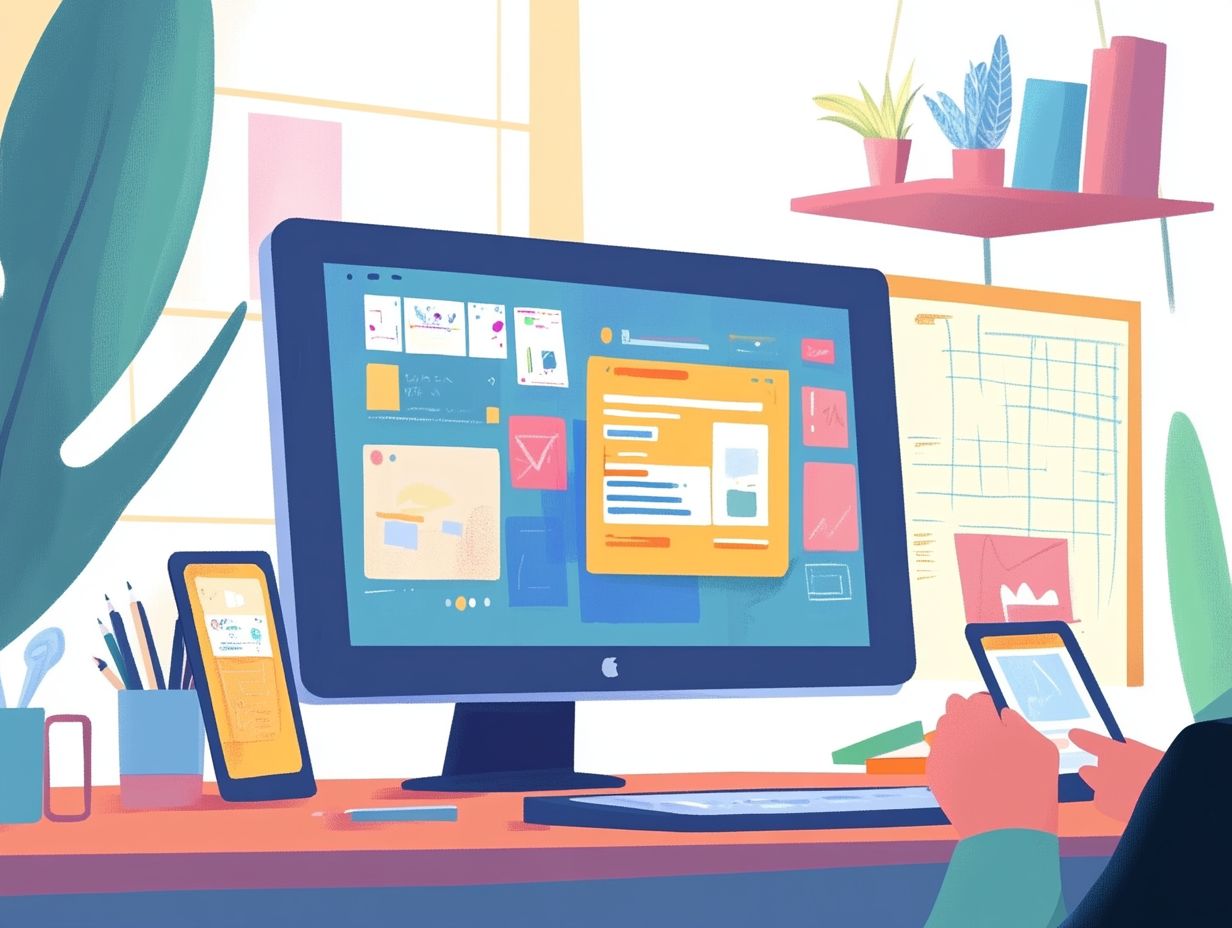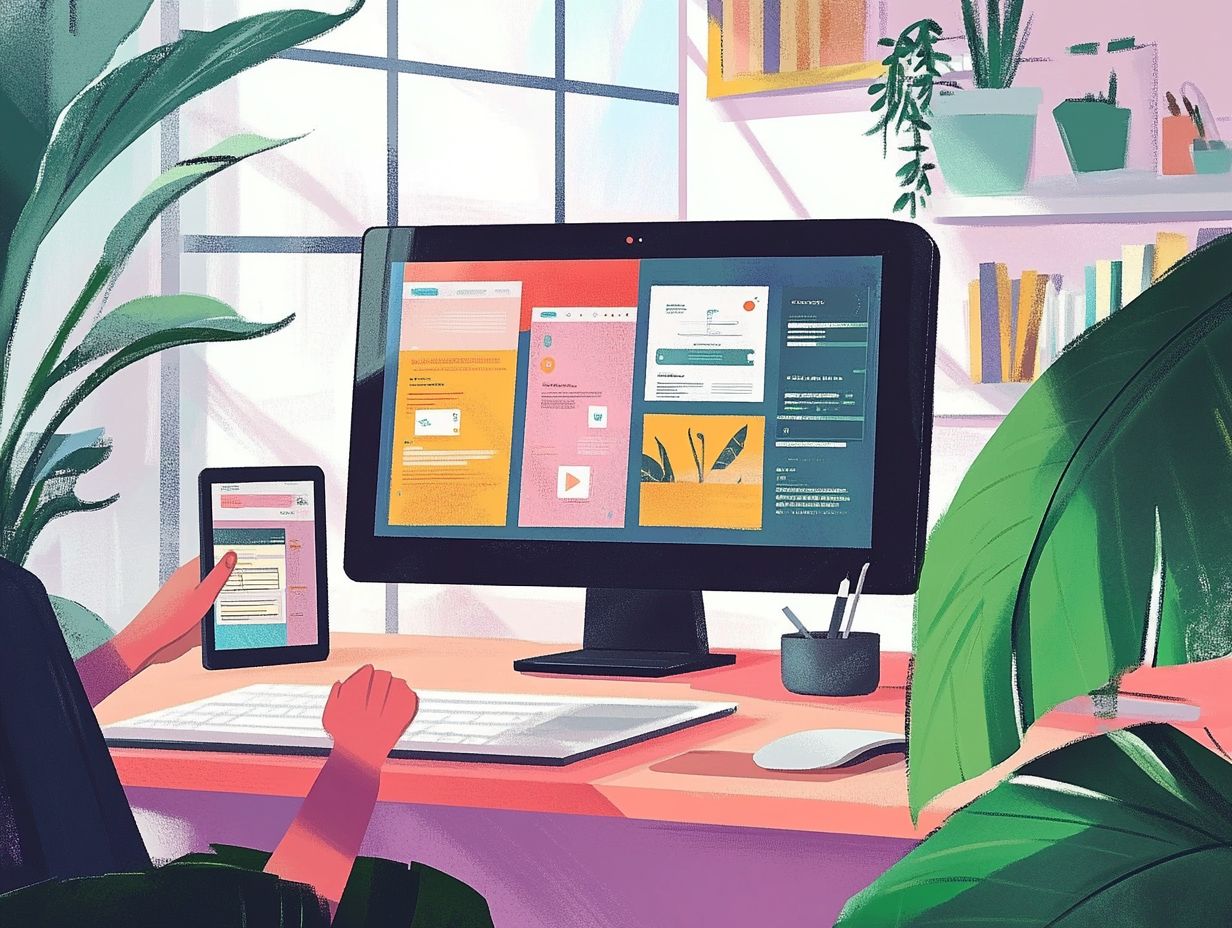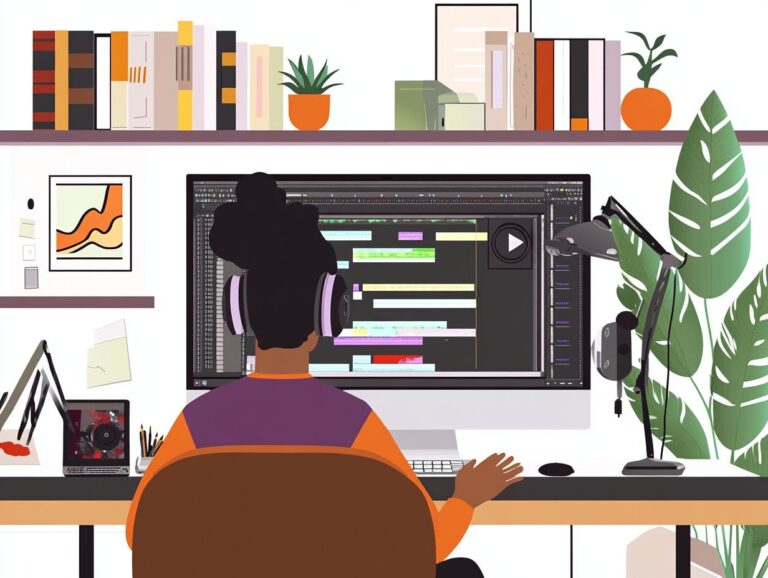How to Create Ui Using AI?

- AI can be used in UI design to gather user data, analyze behavior, and create personalized experiences.
- It’s important to understand the limitations of AI and involve human designers in the process to ensure effective and ethical use.
- The future possibilities of AI in UI design include virtual and augmented reality interfaces, voice and gesture-based UI, and emotional and empathetic UI.
Contents
What is UI and AI?
User Interface (UI) design focuses on the interaction between users and software applications. The primary goal of UI design is to make this interaction as intuitive and efficient as possible while also ensuring it is aesthetically pleasing. In recent years, the integration of AI into UI design has transformed the field by enabling automation and enhancing productivity. AI tools such as Uizard and Autodesigner employ machine learning to customize UI designs based on users’ preferences and behaviors. This approach creates tailored solutions that evolve with users’ journeys across multiple platforms, including mobile apps and e-commerce websites. The combination of UI and AI has sparked creativity in both the design of user interfaces and the ways users engage with applications. For instance, designers have adopted new styles like brutalism and minimalism, while organizations have introduced innovative UI features, such as options for donating money or cryptocurrency through the interface. Examples of this innovation can be seen in the iNOVA Charity Donation mobile app and the Sci-Fi Movies Streaming applications available on the iTunes Store and Google Play Store.
Why Use AI in UI Design?
Integrating AI into UI design offers numerous benefits, enhancing both productivity and creativity throughout the design process. AI tools enable designers to swiftly create and customize design elements, facilitating rapid prototyping of wireframes and mockups with templates tailored for specific user flows. This accelerates the design process and enhances the user experience by allowing designs to adapt to user behavior through AI-generated suggestions and feedback. Technologies such as Uizard and Autodesigner illustrate how design elements can be automatically generated based on textual input, while also automating and optimizing the lengthy, repetitive tasks faced by UI designers through design recommendations.
What are the Benefits of Using AI in UI Design?
The benefits of AI in UI design are numerous and impactful.
- Improved Efficiency: AI tools can automate various aspects of UI design, enabling designers to focus on higher-level creative tasks and enhancing workflow efficiency. Automation features, such as automated design iterations and editable design elements, expedite modifications made in response to user feedback, resulting in designs that better align with user needs.
- Enhanced User Experience: AI can analyze user behavior and generate data-driven insights that inform design decisions, leading to improved UI usability and increased user satisfaction. For instance, AI can enhance accessibility by ensuring that users can effectively interact with the interface, regardless of their physical abilities.
- Increased Personalization: AI-powered UI design tools can tailor interfaces to individual users by adjusting displays and functionalities based on their preferences and behavior patterns. This personalized approach can significantly boost user retention, as evidenced by applications like Spotify and Netflix, where algorithms recommend content that users are likely to enjoy.
- Predictive Analytics: AI give the power tos design teams to leverage data to anticipate future trends and user needs, resulting in a UI that remains relevant and forward-thinking.
- Facilitation of A/B Testing: AI enables real-time A/B testing of design elements, providing rapid feedback on design choices and fostering iterative learning and innovation.
When implemented effectively, these features can dramatically enhance and streamline the process of UI design.
What are the Challenges of Using AI in UI Design?
The challenges of utilizing AI in UI design include several key issues. Firstly, AI algorithms may misjudge or misinterpret user behavior and preferences, resulting in design solutions that do not accurately reflect reality. Additionally, over-reliance on AI-generated design feedback can neglect the emotional and psychological aspects of design that only a human designer can fully comprehend. This reliance on AI can lead to a disconnect between user experience and the intended design outcome, highlighting the importance of human intuition in the design process.
How to Use AI in UI Design?
The use of AI in UI design follows a systematic approach that begins with the collection of user data and culminates in the analysis of that data to develop effective design strategies. This process includes several key steps:
- Collect User Data: User data encompasses any information pertinent to designing the user interface, such as demographics, preferences, and behavioral patterns. This data can be gathered through methods such as surveys, user testing, and tracking user interactions within the application.
- Analyze User Data: After collecting a sufficient amount of user data, designers can employ AI tools to analyze patterns of user behavior. This analysis helps create personalized user experiences tailored to individual preferences.
- Automate Design Processes: One of the significant advantages of incorporating AI in UI design is the ability to automate various design processes, enhancing efficiency and consistency.
By following these steps, designers can leverage AI to enhance the overall user interface and create more engaging user experiences.
1. Gathering User Data

2. Analyzing User Behavior
User behavior analysis plays a crucial role in the UI design process, as it uncovers how users interact with applications and identifies areas for improvement. By leveraging AI-powered analytics tools, designers can gain in-depth insights into user actions, preferences, and engagement levels, enabling data-driven design decisions. This analysis not only reveals trends and patterns but also evaluates the effectiveness of current design elements, allowing for iterative improvements based on user feedback and behaviors. Advanced methodologies, such as heat maps and session recordings, help designers visualize user interactions, providing a clearer understanding of how specific features are utilized. Additionally, machine learning algorithms can process vast amounts of data to predict user behavior and preferences, offering design teams invaluable insights into how their designs may be received prior to making changes. Tools like Google Analytics and Mixpanel are frequently employed to track user journeys and gather actionable insights. By incorporating these technologies into their workflow, designers are able to create more intuitive and user-centered interfaces, ultimately enhancing overall user satisfaction and engagement.
3. Creating Personalized User Experiences
Creating personalized user experiences is a transformative aspect of AI in UI design, enabling designers to customize interfaces based on individual user preferences and behaviors. By leveraging data gathered from user interactions, AI can suggest adjustments that enhance the user journey, making applications more intuitive and engaging. This personalization applies to various design elements, including layout, color palettes, and content recommendations, resulting in a dynamic user experience that resonates with users on a deeper level and increases overall satisfaction. For example, AI algorithms can analyze user behavior patterns to recommend specific features or shortcuts that streamline navigation. An e-commerce application might use this technology to adjust product displays based on past purchases, while a music streaming service could curate playlists that align with a user’s listening habits. Through these tailored experiences, AI not only boosts engagement but also fosters a sense of ownership among users, making the interface feel more relevant and user-friendly. As a result, the integration of AI in UI design not only anticipates user actions but also creates a holistic and enjoyable interaction that evolves over time.
4. Automating Design Processes
Automating design processes through AI enhances efficiency and enables designers to focus more on the creative aspects of their work. AI tools can take over repetitive tasks such as generating wireframes, creating mockups, and providing design feedback based on quantitative metrics. By automating these tasks, designers are freed to concentrate on creative problem-solving and artistic exploration. For instance, AI can utilize machine learning algorithms to analyze user engagement and predict which design elements will resonate most with the target audience. AI-powered analytics provide valuable insights into trends and user preferences, facilitating strategic and informed design iterations. The overall effect of these optimized processes is faster project turnaround times and a collaborative environment where human creativity flourishes alongside intelligent automation.
What are the Best Practices for Using AI in UI Design?
Adopting best practices for AI in UI design is crucial for maximizing benefits while minimizing potential downsides. One important aspect is understanding the limitations of AI; even advanced algorithms can misinterpret nuances in user behavior and design requirements. It is essential to continuously monitor and adjust these algorithms to ensure successful outcomes. Regularly tracking AI performance in real-world applications and updating the algorithms based on user feedback is vital. Additionally, including human designers in the process is necessary to balance creativity with technical efficiency, ensuring that final designs resonate emotionally with users and effectively meet their nuanced needs.
1. Understand the Limitations of AI
Understanding the limitations of AI in UI design is crucial for designers, as this awareness allows them to leverage AI effectively while minimizing potential negative impacts. Although AI is a powerful tool, it often struggles to capture the subtle nuances of human emotion and creative intuition, both of which are vital for effective user experience design. Designers must recognize this limitation and strive to ensure that human insight remains an integral part of any design process that incorporates AI. For instance, when designing user interfaces for specific demographics, AI may lack the ability to fully grasp cultural contexts and the unique needs of different user groups. While an AI tool might identify the most effective color palette for a user interface aimed at a younger audience, it may overlook the cultural significance of certain colors for specific groups. In creating empathy-driven interfaces, such as those for mental health applications, AI’s inability to interpret emotional context may lead to user interfaces that do not align with users’ emotional needs.
2. Continuously Monitor and Adjust AI Algorithms

3. Involve Human Designers in the Process
Involving human designers in the AI-driven UI design process fosters collaboration that enhances creativity and innovation. While AI can automate various tasks and provide valuable insights, human designers contribute emotional intelligence, contextual understanding, and creative problem-solving skills, which are essential for creating designs that resonate with users. Their perspectives are particularly important when addressing the nuanced needs of diverse user groups. For instance, when a team integrates user feedback into AI recommendations during development, they not only refine the algorithms but also ensure that the final product aligns with users’ expectations. This collaboration can lead to iterative improvements, making the design more accessible and intuitive. Additionally, incorporating human input into AI design helps safeguard against biases, ensuring that the technology reflects a broader social spectrum. Ultimately, the alliance between human insight and AI efficiency can result in solutions that are not only functional but also profoundly impactful.
What are the Future Possibilities of AI in UI Design?
The future possibilities of AI in UI design are vast, and ongoing advancements in technology will pave the way for innovations in user interfaces that we cannot yet conceive. In the coming years, AI will play a pivotal role in the development of virtual and augmented reality interfaces, creating increasingly immersive experiences that transform how users engage with products. Additionally, AI will facilitate greater personalization by dynamically adapting interfaces in real time based on users’ emotional states and preferences, resulting in a more engaging and meaningful journey across applications.
1. Virtual and Augmented Reality Interfaces
Virtual and augmented reality interfaces represent the most advanced form of user interface available today, and artificial intelligence (AI) will play a significant role in enhancing this technology. By facilitating adaptive and immersive interfaces that seamlessly blend real and digital environments, AI-powered design will elevate user interaction to unprecedented levels and unlock new applications across diverse fields, from gaming to e-commerce. This integration will introduce interactive elements that were previously unattainable. The impact of AI on augmented and virtual reality interfaces is already evident in applications like training simulations, where real-time data analysis can tailor the simulations to meet individual user needs. In the healthcare sector, augmented reality is being utilized by surgeons to visualize complex procedures, while AI analyzes medical data to provide recommendations for the best course of action. In retail, AI-powered virtual assistants are enhancing the customer experience through augmented reality, enabling users to visualize products in their homes before making a purchase. These systems are not only improving user satisfaction but also increasing productivity and efficiency across various industries.
2. Voice and Gesture-based UI
Voice and gesture-based user interfaces (UI) are emerging trends in design, propelled by advancements in AI that facilitate more natural and intuitive user interactions. These interfaces allow users to engage with applications using their voice or hand motions, reducing the reliance on traditional input methods like keyboards and touchscreens. As AI technology continues to evolve, we can anticipate that these interactions will become increasingly sophisticated, thereby enhancing user experience and accessibility for diverse audiences. Currently, smart assistants such as Amazon’s Alexa and Apple’s Siri enable users to control devices, play music, and manage schedules through simple voice commands. Additionally, gesture recognition technology in systems like Microsoft s Kinect allows users to navigate interfaces using natural hand movements, creating a more immersive environment. The potential applications of these technologies extend to gaming, virtual reality, and healthcare, where voice commands can streamline patient interactions. As developers continue to experiment and innovate, the integration of voice and gesture-based UI is likely to redefine how users connect with their devices, making technology more responsive and user-friendly.
3. Predictive and Adaptive UI
Predictive and adaptive user interfaces (UI) represent some of the most advanced forms of responsive design, utilizing artificial intelligence (AI) to modify the interface based on anticipated user behavior and real-time interactions. These interfaces provide customized content and functionality, enhancing user engagement and satisfaction. By combining predictive analytics with adaptive interfaces, designers and developers can create experiences tailored to individual users. As users interact with the application, the UI learns and optimizes its responses, suggesting and arranging services and layouts that feel natural and relevant. The advantages of this technology extend beyond mere engagement; it fundamentally transforms how individuals interact with digital experiences. Predictive and adaptive UIs foster user loyalty and encourage long-term usage, cultivating a deeper and more meaningful relationship between the application and its users by continually adapting to evolving preferences and trends.
4. Emotional and Empathetic UI

Frequently Asked Questions
Can AI be used to create a user interface?
Yes, AI technology can be used to create a user interface with advanced features and personalized design elements.
What are the benefits of using AI in UI creation?
Using AI in UI creation can result in a more intuitive and user-friendly interface, faster design processes, and better customization options.
Do I need coding skills to create a UI using AI?
No, AI tools for UI creation are designed to be user-friendly and do not require coding skills. However, some basic design knowledge may be helpful.
Can AI create a UI for any platform or device?
Yes, AI can be used to create UIs for various platforms and devices, including desktop, mobile, and web.
How does AI assist in the UI design process?
AI can assist in the UI design process by analyzing user behavior and preferences, generating design suggestions, and automating repetitive tasks.
Are there any limitations to using AI in UI creation?
While AI technology continues to advance, there may still be limitations in terms of creativity and human touch in the design process. It is important to find a balance between AI and human input for the best results.






